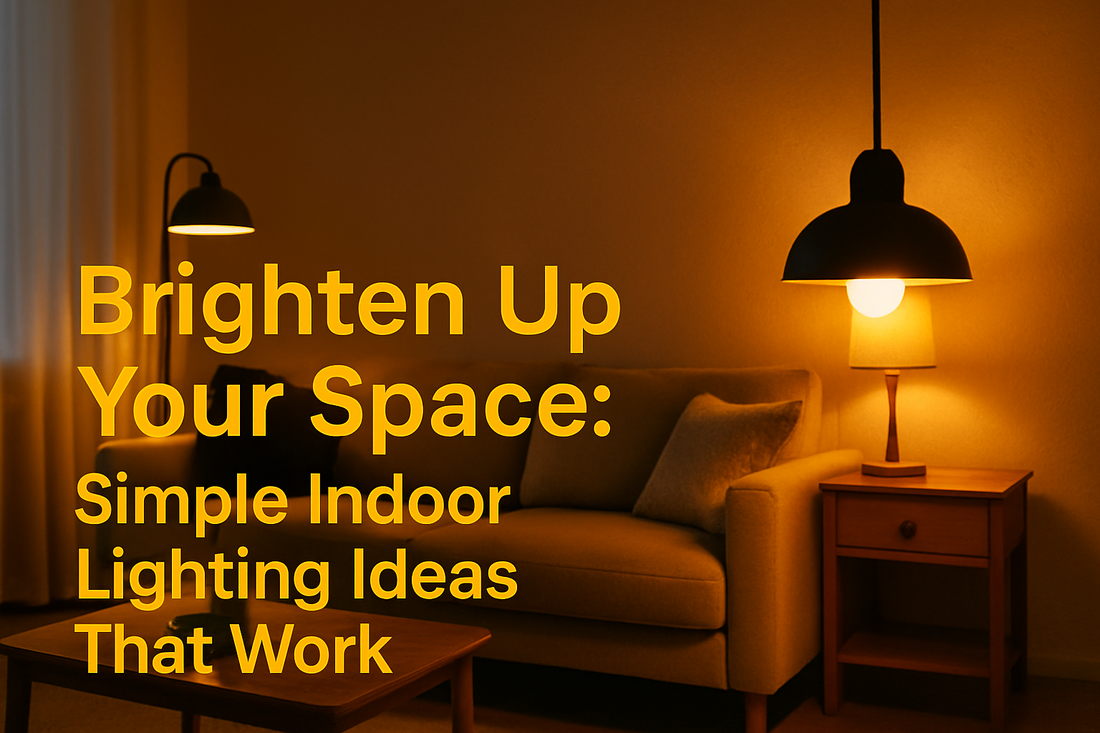
Brighten Up Your Space: Simple Indoor Lighting Ideas That Work
Share
Indoor lighting plays a big role in how your home feels, looks, and functions. It is not only about being able to see clearly, but it is also about creating the proper mood, enhancing your comfort, and getting your energy bills down. It doesn’t matter whether you are decorating something completely new or simply redecorating that which you already have; one thing that can really make the difference is the lighting.
In this guide, we'll walk you through some of the best indoor lighting ideas. We will not speak big words, make this complicated, or AI-like sounding suggestions. These really are useful instructions to make your house glow.
Why Indoor Lighting Matters
Indoor lighting affects everything from how you feel in a room to how much energy you use. Good lighting is able to:
• Warm up the atmosphere in your place
• Assist you in focusing better
• Less vision tension in the eyes
• Flash your decor
• When properly done, it reduces your energy bill.
Poor lighting, however, may render a place drab, cramped, or even depressing. This is why one should listen to it.
Types of Indoor Lighting
There are three main types of indoor lighting. Both of them have different purposes; together, they form a well-balanced and illuminated room.
1. Ambient Lighting
This gives you your major source of light in a room. It may be provided via overhead fittings, hanging lamps, or huge floor lamps. Consider it the lower tier of illumination.
2. Task Lighting
This gives you a clearer vision whenever you want to do a particular thing, such as reading, cooking, or working. Good examples are under-cabinet lights in the kitchen, vanity lights, and desk lamps.
3. Accent Lighting
It is all about style in accent lighting. It has an emphasis on particular points or items (such as art, bookshelves, or architecture) to provide a room with further depth and charisma.
Best Indoor Lighting Ideas for Every Room
Living Room
The living room is your relaxation room, entertaining room, and all that. Here, the layering of your lights is important.
• Utilize a mixture of sources: Put together a ceiling lamp, floor lamp, and table lamps.
• Install dimmers: Depending on the time or mood, turn up or down the lights.
• Highlight decor: Spotlight something.
Kitchen
The kitchen is an area rich in tasks, hence it is vital to have bright, focused lighting.
• Put under-cabinet lighting: These lights are excellent when food is being prepared and when one needs a lot of 3 illumination on a counter.
• Use pendant lights: Place them over islands or dining spaces and serve both form and purpose.
• Use bright white bulbs: They assist in visibility when performing cooking or cleaning.
Bedroom
This is because your bedroom is meant to be quiet and comfortable, and you should get practical lighting as well.
• Install dimmer lights on the bedside: Ideal to read at night.
• Warm light bulbs: This provides a relaxing environment.
• Put in dimmers or smart bulbs: This way, you can change the brightness when required.
Bathroom
The bathroom should have functional and flattering lighting.
• Install spotlights around the mirror: Spotlights should not create shadows, so put lights on both sides.
• Install ceiling light: A flush-mount fixture normally does the trick.
• Moisture-safe fixtures are best: Particularly around the shower or tub.
Study Room or Home Office
Focus and productivity require good lighting.
• acquire a bright lamp on the desk: Find one that has adjustable brightness.
• Work with daylight bulbs: These would simulate natural sunlight and save your eyes.
• No glare screens: Don’t place lights in a position where they will reflect off your screen.
Selecting the Proper Bulbs
Light bulbs do not all shine alike. Here's how to pick the best ones for your indoor lighting needs:
• LED Bulbs: energy-efficient, long-lasting replacements, and can come in a wide variety of brightness.
• Colour Temperature: It is measured in Kelvins (K). Cool (below 2700K, 3000K) temperatures are warm and comfortable. The higher numbers (5000K-6500K) have a damp and energising quality.
• Lumens: This is indicative of the brightness of the bulb. The more the lumens, the brighter the light.
Be consistent with the way your bulbs are matched with the use of the room. Relaxing spaces need to have warm light, and working areas need cool light.
Energy-Saving Tips for Indoor Lighting
It does not mean one should make do with poor female lighting in order to save energy. Below are some of the suggestions to guide you in reducing power consumption while making your home bright:
• Replace the bulbs with LED bulbs: These consume up to 80 per cent less and are much more long-lasting.
• Dim the lights and set timers: Light up only as much as you require when you require it.
• Motion sensor: Can be used in closets or bathrooms, where lights can be left on all the time.
• Switch off the light in unoccupied rooms: There is more than $60 to gain by doing that.
Budget-Friendly Indoor Lighting Ideas
A fancy lighting does not mean having to empty the purse in a bid to light the house. Some of the economic suggestions are as follows:
• Thrift lamps and fixtures: Second-hand stores sometimes are filled with good deals.
• Install the use of string lights: They contribute to the ambience and sense of charm, particularly in bedrooms or corner niches.
• DIY lamp transformations: Some clash of paint or a new colour can give appearance to a worn lamp.
• Smart plugs or bulbs: These allow using a phone to regulate a light and, in many cases, are cheap.
Indoor Lighting Mistakes to Avoid
Wanting to achieve a lot in your space: you can dramatically change your space by avoiding a couple of typical errors:
• Use of a Single Source of light: The light should be combined by mixing ambient, task, and accent lights to create a balance.
• Selecting an incorrect colour of a bulb: Warm or cool light makes a difference than you could imagine.
• Neglecting shadows: Look at the location of shadows, particularly in the workplace.
• Oblivious to dimmer solutions: An inexpensive way to add flexibility without replacement.
Quick Tips for Better Indoor Lighting
• Put up mirrors that aid reflection of light and make rooms appear large
• Regularly clean your light fixtures in order to keep them bright
• Replace burn-out bulbs by two at a time, to maintain an even light of sorts
• Use smart bulbs that you can change hue and intensity easily
Final Thoughts
Indoor lighting is one of the easiest ways to change how your home feels—without major renovations or a big budget. A combination of proper planning, the correct bulbs, and some clever thoughts makes a space that is both lovely looking and practical.
Lighting should ideally have a mix of design and functionality. Your bedroom, kitchen, or study room may all be lit differently, but the essence is that it should serve both stylish and practical purposes. But as it may turn out, good lighting does not only mean brightness; it also means how good you feel with it.
Okay, go on, brighten up your life by one room at a time.









